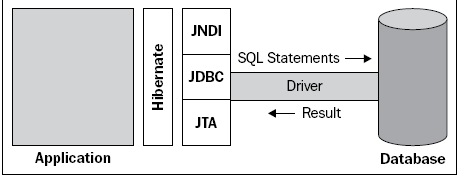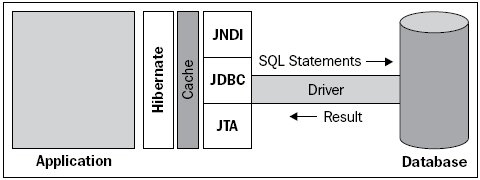Object relational mapping
As the previous discussion shows, we are looking for a solution that enables applications to work with the object representation of the data in database tables, rather than dealing directly with that data. This approach isolates the business logic from any relational issues that might arise in the persistence layer. The strategy to carry out this isolation is generally called object/relational mapping (O/R Mapping, or simply ORM).
A broad range of ORM solutions have been developed. At the basic level, each ORM framework maps entity objects to JDBC statement parameters when the objects are persisted, and maps the JDBC query results back to the object representation when they are retrieved. Developers typically implement this framework approach when they use pure JDBC. Furthermore, ORM frameworks often provide more sophisticated object mappings, such as the mapping of inheritance hierarchy and object association, lazy loading, and caching of the persistent objects. Caching enables ORM frameworks to hold repeatedly fetched data in memory, instead of being fetched from the database in the next requests, causing deficiencies and delayed responses, the objects are returned to the application from memory. Lazy loading, another great feature of ORM frameworks, allows an object to be loaded without initializing its associated objects until these objects are accessed.
ORM frameworks usually use mapping definitions, such as metadata, XML files, or Java annotations, to determine how each class and its persistent fields should be mapped onto database tables and columns. These frameworks are usually configured declaratively, which allows the production of more flexible code.
Many ORM solutions provide an object query language, which allows querying the persistent objects in an object-oriented form, rather than working directly with tables and columns through SQL. This behavior allows the application to be more isolated from the database properties.
Hibernate as an O/R Mapping solution
For a long time, Hibernate has been the most popular persistence framework in the Java community. Hibernate aims to overcome the already mentioned impedance mismatch between object-oriented applications and relational databases.
With Hibernate, we can treat the database as an object-oriented store, thereby eliminating mapping of the object-oriented and relational environments. Hibernate is a mediator that connects the object-oriented environment to the relational environment. It provides persistence services for an application by performing all of the required operations in the communication between the object-oriented and relational environments. Storing, updating, removing, and loading can be done regardless of the objects persistent form. In addition, Hibernate increases the application's effectiveness and performance, makes the code less verbose, and allows the code to be more focused on business rules than persistence logic. The following screenshot depicts Hibernates role in persistence:

Hibernate fully supports object orientation, meaning all aspects of objects, such as association and inheritance, are properly persisted. Hibernate can also persist object navigation, that is, how an object is navigable through its associated objects. It caches data that is fetched repeatedly and provides lazy loading, which notably enhances database performance. As you will see, Hibernate provides caches in two levels: first-level built-in, and second-level pluggable cache strategies. Th e first-level cache is a required property for any ORM to preserve object consistency. It guaranties that the application always works with consistent objects. This is originated from the fact that many threads in the application use the ORM to persist the objects which might potentially be associated to the same table rows in the database. The following screenshot depicts the role of a cache when using Hibernate:

Unlock access to the largest independent learning library in Tech for FREE!
Get unlimited access to 7500+ expert-authored eBooks and video courses covering every tech area you can think of.
Renews at $19.99/month. Cancel anytime
Hibernate provides its own query language, which is Hibernate Query Language (HQL). At runtime, HQL expressions are transformed to their corresponding SQL statements, based on the database used. Because databases may use different versions of SQL and may expose different features, Hibernate presents a new concept, called an SQL dialect, t o distinguish how databases differ. Furthermore, Hibernate allows SQL expressions to be used either declaratively or programmatically, which is useful in specific situations when Hibernate does not satisfy application persistence requirements.
Hibernate keeps track of object changes through snapshot comparisons to prevent unnecessary updating.
Other O/R Mapping solutions
Although Hibernate is the most popular persistence framework, many other frameworks do exist. Some of these are explained as follows:
- Enterprise JavaBeans (EJB): It is a standard J2EE (J ava 2 Enterprise Edition) technology that defines a different type of persistence by presenting entity beans. Mostly, for declarative middleware services that are provided by the application server, such as transactions, EJB may be preferred for architecture. However, due to its complexity, nontransparent persistence, and need for a container (all of which make it difficult to implement, test, and maintain), EJB is less often used than other persistence frameworks.
- iBatis SQL Map: It is a result set–mapping framework which works at the SQL level, allowing SQL string definitions with parameter placeholders in XML files. At runtime, the placeholders are filled with runtime values, either from simple parameter objects, JavaBeans properties, or a parameter map. To their advantage, SQL maps allow SQL to be fully customized for a specific database. To their disadvantage, however, these maps do not provide an abstraction from the specific features of the target database.
- Java Data Objects (JDO): It is a specification for general object persistence in any kind of data store, including relational databases and object-oriented databases. Most JDO implementations support using metadata mapping definitions. JDO provides its own query language, JDOQL, and its own strategy for change detection.
- TopLink: It provides a visual mapping editor (Mapping Workbench) and offers a particularly wide range of object, relational mappings, including a complete set of direct and relational mappings, object-to-XML mappings, and JAXB (Java API for XML Binding) support. TopLink provides a rich query framework that supports an object-oriented expression framework, EJB QL, SQL, and stored procedures. It can be used in either a JSE or a JEE environment.
Hibernate designers has borrowed many Hibernate concepts and useful features from its ancestors
Hibernate versus other frameworks
Unlike the frameworks just mentioned, Hibernate is easy to learn, simple to use, comprehensive, and (unlike EJB) does not need an application server. Hibernate is well documented, and many resources are available for it. Downloaded more than three million times, Hibernate is used in many applications around the world. To use Hibernate, you need only J2SE 1.2 or later, and it can be used in stand-alone or distributed applications.
The current version of Hibernate is 3, but the usage and configuration of this version are very similar to version 2. Most of the changes in Hibernate 3 are compatible with Hibernate 2.
Hibernate solves many of the problems of mapping objects to a relational environment, isolating the application from getting involved in many persistence issues. Keep in mind that Hibernate is not a replacement for JDBC. Rather, it can be thought of as a tool that connects to the database through JDBC and presents an object-oriented, application-level view of the database.
 United States
United States
 Great Britain
Great Britain
 India
India
 Germany
Germany
 France
France
 Canada
Canada
 Russia
Russia
 Spain
Spain
 Brazil
Brazil
 Australia
Australia
 Singapore
Singapore
 Canary Islands
Canary Islands
 Hungary
Hungary
 Ukraine
Ukraine
 Luxembourg
Luxembourg
 Estonia
Estonia
 Lithuania
Lithuania
 South Korea
South Korea
 Turkey
Turkey
 Switzerland
Switzerland
 Colombia
Colombia
 Taiwan
Taiwan
 Chile
Chile
 Norway
Norway
 Ecuador
Ecuador
 Indonesia
Indonesia
 New Zealand
New Zealand
 Cyprus
Cyprus
 Denmark
Denmark
 Finland
Finland
 Poland
Poland
 Malta
Malta
 Czechia
Czechia
 Austria
Austria
 Sweden
Sweden
 Italy
Italy
 Egypt
Egypt
 Belgium
Belgium
 Portugal
Portugal
 Slovenia
Slovenia
 Ireland
Ireland
 Romania
Romania
 Greece
Greece
 Argentina
Argentina
 Netherlands
Netherlands
 Bulgaria
Bulgaria
 Latvia
Latvia
 South Africa
South Africa
 Malaysia
Malaysia
 Japan
Japan
 Slovakia
Slovakia
 Philippines
Philippines
 Mexico
Mexico
 Thailand
Thailand
















